The Intel 6th Gen Skylake Review: Core i7-6700K and i5-6600K Tested
by Ian Cutress on August 5, 2015 8:00 AM ESTWhat You Can Buy: Linux Performance
Built around several freely available benchmarks for Linux, Linux-Bench is a project spearheaded by Patrick at ServeTheHome to streamline about a dozen of these tests in a single neat package run via a set of three commands using an Ubuntu 11.04 LiveCD. These tests include fluid dynamics used by NASA, ray-tracing, OpenSSL, molecular modeling, and a scalable data structure server for web deployments. We run Linux-Bench and have chosen to report a select few of the tests that rely on CPU and DRAM speed.
C-Ray: link
C-Ray is a simple ray-tracing program that focuses almost exclusively on processor performance rather than DRAM access. The test in Linux-Bench renders a heavy complex scene offering a large scalable scenario.
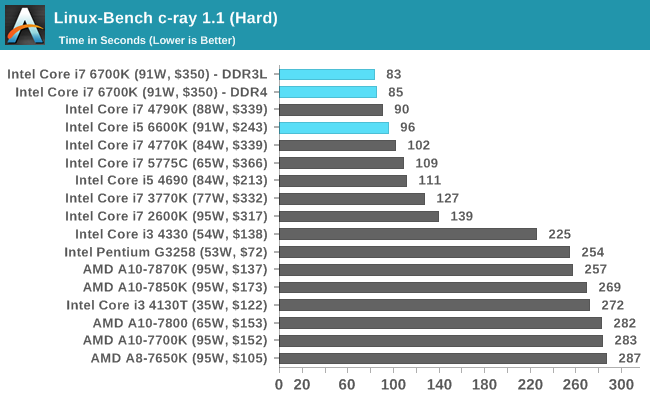
NAMD, Scalable Molecular Dynamics: link
Developed by the Theoretical and Computational Biophysics Group at the University of Illinois at Urbana-Champaign, NAMD is a set of parallel molecular dynamics codes for extreme parallelization up to and beyond 200,000 cores. The reference paper detailing NAMD has over 4000 citations, and our testing runs a small simulation where the calculation steps per unit time is the output vector.
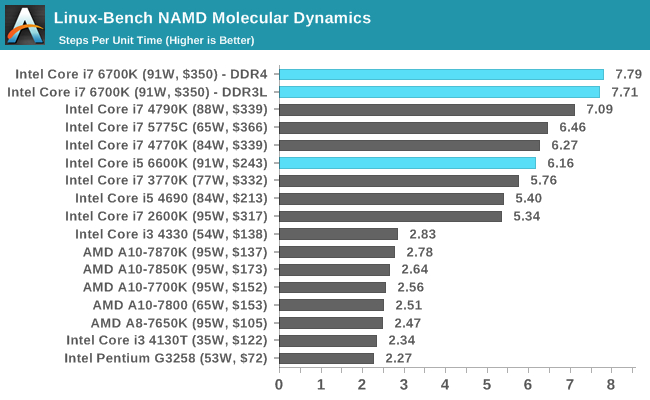
NPB, Fluid Dynamics: link
Aside from LINPACK, there are many other ways to benchmark supercomputers in terms of how effective they are for various types of mathematical processes. The NAS Parallel Benchmarks (NPB) are a set of small programs originally designed for NASA to test their supercomputers in terms of fluid dynamics simulations, useful for airflow reactions and design.
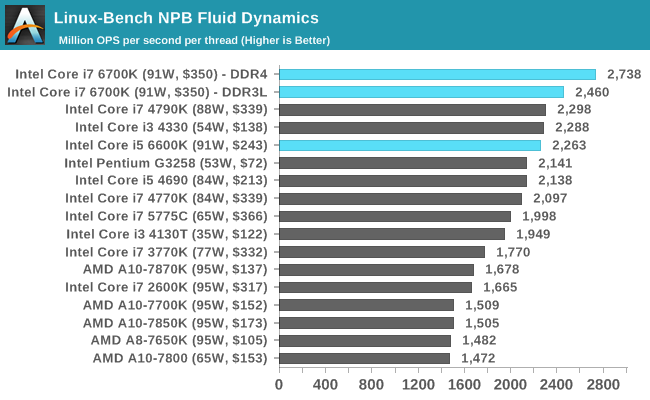
Redis: link
Many of the online applications rely on key-value caches and data structure servers to operate. Redis is an open-source, scalable web technology with a b developer base, but also relies heavily on memory bandwidth as well as CPU performance.
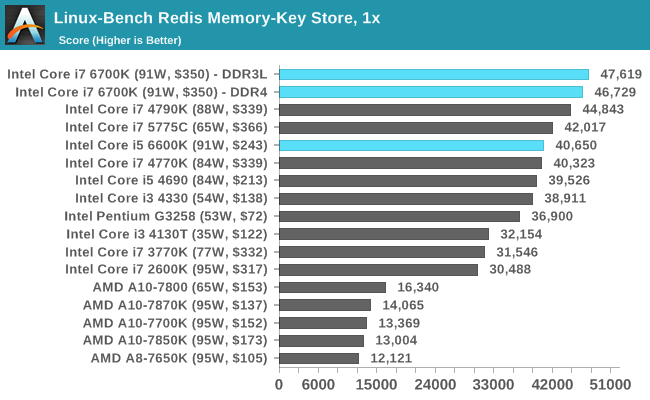
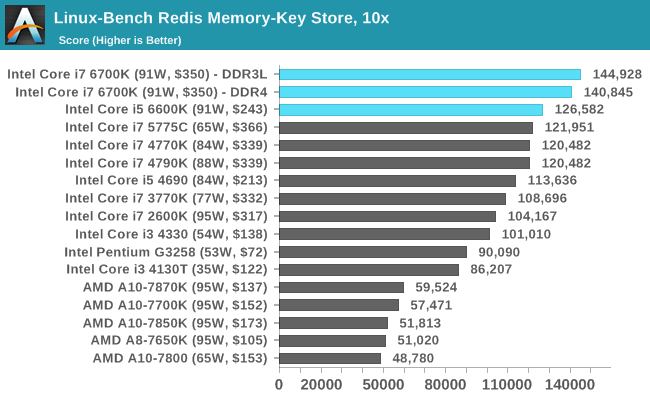
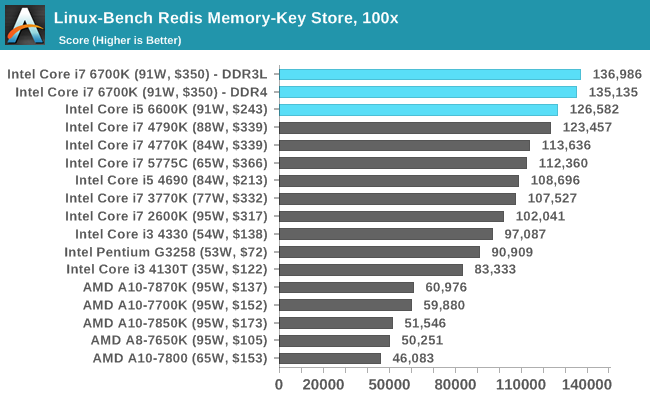










477 Comments
View All Comments
mkozakewich - Thursday, August 6, 2015 - link
It's unlikely you'll be seeing doubles and doubles anymore. If you look at what's been going on for the past several years, we're moving to more efficient processes instead of improving performance. I'm sure Intel's end goal is to make powerful CPUs for devices that fit into people's pockets. At that point you might see more start going into raw performance.edlee - Wednesday, August 5, 2015 - link
i am not sure why conclusion to the review makes it seem i7-2600k users should upgrade to this.If you are a gamer, there is no 25% improvement in average or minimum frame rate, its 3-6% at best.
Is this the future of intel's tock strategy, to give very little improvement to gamers?
VeauX - Wednesday, August 5, 2015 - link
On the gaming side, you'll never see a speed bump if you are not CPU Limited. Once you have a decent CPU, just put your money in GPU, period.Nagorak - Wednesday, August 5, 2015 - link
CPU is almost irrelevant for games at this point. As games start to take advantage of more cores, older processors are utilized more efficiently, further negating the need to upgrade. DX12 may improve this further.I sort of wonder if Intel isn't on a path to some trouble here. There's basically no point for anyone to upgrade their CPU anymore, not even gamers. Other than a few specialized applications the increase in performance just doesn't really matter, if it exists at all.
AndrewJacksonZA - Thursday, August 6, 2015 - link
I also sometimes think that, but then I remember that we developers *WILL* find a way to make use of more computing power.Having said that, I still can't quite justify me upgrading from my E6750 and 6670 @ 1240 x 1024. I slapped in an SSD in February last year and it was like I got a brand new machine.
Chrome and Edge on Win10 lag a teeny tiny bit though, maybe I can use that as my justification... Perhaps a 5960X or a 5930K though - more cores FTW? Or perhaps a 6700K and get it to 5GHz for the rights to claim some "5GHz Daily Driver" epeen... ;-)
Zoomer - Friday, August 14, 2015 - link
Exactly, I reached the opposite conclusion as Ian. There is no point in upgrading even from SB. If you do, stick to DDR3. Only GTA5 benefits from DDR4.It's interesting to see if regular DDR3 sticks can run on Skylake, perhaps by bumping the Vsa, voltages. Not clear if Ian's overclocking tests were with the IGP disabled - would be interesting to see if disabling the IGP / reducing Fgt, Vgt helps overclocking any.
StevoLincolnite - Wednesday, August 5, 2015 - link
I'm still happily sitting with my Sandy-Bridge-E. Still handles everything you could throw at it just fine... And still gives Intel's $1,000 chips a run for their money whilst sitting at 5Ghz.mapesdhs - Wednesday, August 12, 2015 - link
Yup, that's why my most recent gaming build was a R4E & 3930K, cost less than a new HW build, much quicker overall. My existing SB gaming PC is 5GHz aswell (every 2700K I've tried handles 5.0 just fine).leexgx - Monday, August 10, 2015 - link
hmm maybe i can upgrade from my i7-920 now (really any of the newer intel cpus are faster then it)sheeple - Thursday, October 15, 2015 - link
DON'T BE STUPID SHEEPLE!!! NEW DOES NOT ALWAYS = BETTER!